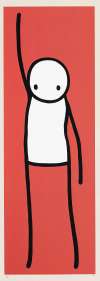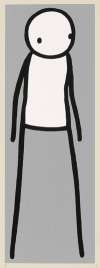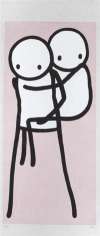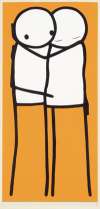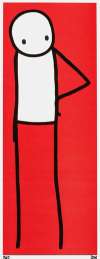Standing
Figure
A lithograph print depicting the artist’s iconic, six-line-2-dot stick man, Standing Figure was released as part of Stik’s 2015 coffee table book. Arguably the quintessential Stik series, it depicts his stickman in isolation, in a frontal, relaxed stance across five colourways—blue, orange, red and yellow.
Stik Standing Figure For sale
Standing Figure Value (5 Years)
With £5369 in the past 12 months, Stik's Standing Figure series is one of the most actively traded in the market. Prices have varied significantly – from £280 to £8400 – driven by fluctuations in factors like condition, provenance, and market timing. Over the past 12 months, the average selling price was £671, with an average annual growth rate of 1.51% across the series.
Standing Figure Market value
Auction Results
| Artwork | Auction Date | Auction House | Return to Seller | Hammer Price | Buyer Paid |
|---|---|---|---|---|---|
 Standing Figure (teal) Stik Signed Print | 18 Sept 2025 | Tate Ward Auctions | £723 | £850 | £1,150 |
 Standing Figure (red) Stik Signed Print | 18 Sept 2025 | Tate Ward Auctions | £510 | £600 | £800 |
 Standing Figure (yellow) Stik Signed Print | 18 Sept 2025 | Tate Ward Auctions | £680 | £800 | £1,050 |
 Standing Figure (orange) Stik Signed Print | 17 Oct 2024 | Chiswick Auctions | £340 | £400 | £550 |
 Standing Figure (complete set) Stik Signed Print | 3 Sept 2024 | Forum Auctions London | £1,275 | £1,500 | £1,900 |
 Standing Figure (grey) Stik Signed Print | 3 Sept 2024 | Forum Auctions London | £425 | £500 | £650 |
 Standing Figure (blue) Stik Signed Print | 7 Jun 2023 | Tate Ward Auctions | £978 | £1,150 | £1,500 |
Sell Your Art
with Us
with Us
Join Our Network of Collectors. Buy, Sell and Track Demand
Meaning & Analysis
A lithograph print depicting the artist’s iconic, six-line-2-dot stick man, Standing Figure was released as part of Stik’s 2015 coffee table book. Perhaps the most important motif in Stik’s portfolio, the lone stickman was a fitting inclusion as a print in the coffee table book. The lithograph is available in blue, orange, red and yellow.
In the early days of the project, the lone stickman was particularly prominent, present in works like Diva and Beggar: “At first I only painted lonely people. It was my way of reflecting on my personal struggles. Then as my circumstances improved, I became involved with causes and the figure changed as its context changed.” The isolation invoked by the period of homelessness which Stik refers to as pivotal in the birth of his signature stickman is potently present in Standing Figure, which depicts a nervous, forlorn figure with a sideways glance. The anonymity and universality of Standing Figure encapsulate Stik’s notion of the mere outline of the body being rich in meaning and communication: “You can tell a lot about someone just by the way they’re moving their back or their eyes. There doesn’t need to be a great deal of detail there. You can see it from across the road. You can see someone silhouetted against a white wall in the night and check whether they’re walking in an aggressive way or if they’re someone you know.”
Calling it ‘a journal of the progression of the Stik project’, Stik remarks that a key motivation for the creation of his book was a growing awareness of the relationship between his art and the community which had grown over the years - a relationship to which his work with the Hackney Citizen pays testament: “I’d speak to the editors and we’d pick a local news story. I would find a specific place relevant to that story, do a mural and then I’d write a brief column explaining why that painting was there and what news issue it was relating to.“ It was in this collaboration that Stik recognised the relational and intersocial element of his work: “Doing that monthly piece really made me think about street art on a much deeper level and what sort of impact I could have on the community – how I could represent my community through art. So that was the catalyst for the book.”











